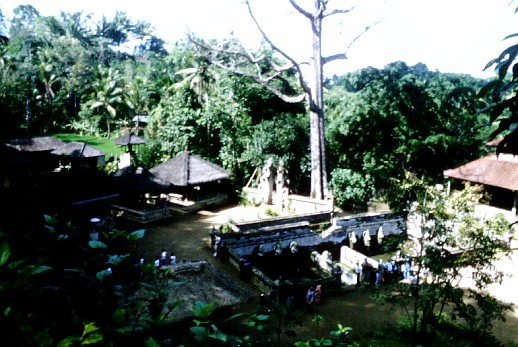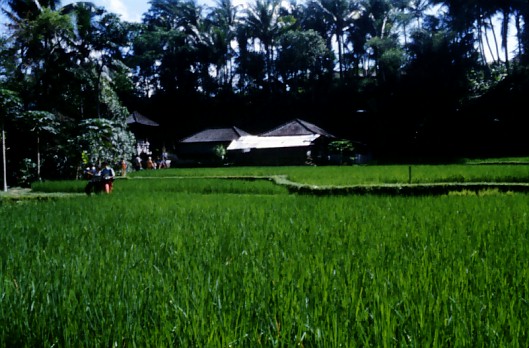Goa Gajah |
|||||||||||||||||||||||||||||||||||||||||||||||||||||||||||||||||||||||||||||||||||||||||||||||||||||||||||||||||||||||||||||||||||||||||||||||||||||||||||||||||||||||||||||||||||||||||||||||||||||||||||||||||||||||||||||||||||||||||||||||||||||||||||||||||||||||||||||||||||||||||||||||||||||||||||||||||||||||||||||||||||||||||||||||||||||||||||||||||||||||||||||||||||||||||||||||||||||||||||||||||||||||||||||||||||||||||||||||||||||||||||||||||||||||||||||||||||||||||||||||||||||||||||||||||||
|
|
 The next
stop was Goa Gajah - the Elephant Cave. This ancient temple, situated
around a carved cave entrance, is a major tourist attraction, with
busloads of tourists arriving in the parking lot all the time.
Out of respect for the temple, visitors are requested to wear
sarongs, which we had brought with us from the States, much to
Dewa's amazement! You walk down a series of steps to the temple. The next
stop was Goa Gajah - the Elephant Cave. This ancient temple, situated
around a carved cave entrance, is a major tourist attraction, with
busloads of tourists arriving in the parking lot all the time.
Out of respect for the temple, visitors are requested to wear
sarongs, which we had brought with us from the States, much to
Dewa's amazement! You walk down a series of steps to the temple.
|
||||||||||||||||||||||||||||||||||||||||||||||||||||||||||||||||||||||||||||||||||||||||||||||||||||||||||||||||||||||||||||||||||||||||||||||||||||||||||||||||||||||||||||||||||||||||||||||||||||||||||||||||||||||||||||||||||||||||||||||||||||||||||||||||||||||||||||||||||||||||||||||||||||||||||||||||||||||||||||||||||||||||||||||||||||||||||||||||||||||||||||||||||||||||||||||||||||||||||||||||||||||||
|
|
 In common
with many temples, Goa Gajah has springs and pools of holy water.
This is a rather dried up pool - they probably only fill it when
it is going to be used. In common
with many temples, Goa Gajah has springs and pools of holy water.
This is a rather dried up pool - they probably only fill it when
it is going to be used.
|
||||||||||||||||||||||||||||||||||||||||||||||||||||||||||||||||||||||||||||||||||||||||||||||||||||||||||||||||||||||||||||||||||||||||||||||||||||||||||||||||||||||||||||||||||||||||||||||||||||||||||||||||||||||||||||||||||||||||||||||||||||||||||||||||||||||||||||||||||||||||||||||||||||||||||||||||||||||||||||||||||||||||||||||||||||||||||||||||||||||||||||||||||||||||||||||||||||||||||||||||||||||||
|
|
 The
famous cave entrance is elaborately carved. Inside the cave is a statue
of the Hindu character Ganesh (Ganesa) - half elephant, half boy - from
which the temple gets its name. The
famous cave entrance is elaborately carved. Inside the cave is a statue
of the Hindu character Ganesh (Ganesa) - half elephant, half boy - from
which the temple gets its name.
|
||||||||||||||||||||||||||||||||||||||||||||||||||||||||||||||||||||||||||||||||||||||||||||||||||||||||||||||||||||||||||||||||||||||||||||||||||||||||||||||||||||||||||||||||||||||||||||||||||||||||||||||||||||||||||||||||||||||||||||||||||||||||||||||||||||||||||||||||||||||||||||||||||||||||||||||||||||||||||||||||||||||||||||||||||||||||||||||||||||||||||||||||||||||||||||||||||||||||||||||||||||||||
|
|
 This
is one of the springs of holy water. People were filling
containers from it while we were there. This
is one of the springs of holy water. People were filling
containers from it while we were there.
|
||||||||||||||||||||||||||||||||||||||||||||||||||||||||||||||||||||||||||||||||||||||||||||||||||||||||||||||||||||||||||||||||||||||||||||||||||||||||||||||||||||||||||||||||||||||||||||||||||||||||||||||||||||||||||||||||||||||||||||||||||||||||||||||||||||||||||||||||||||||||||||||||||||||||||||||||||||||||||||||||||||||||||||||||||||||||||||||||||||||||||||||||||||||||||||||||||||||||||||||||||||||||
|
|
 Behind the
temple is a rice field where they grow rice used in
temple ceremonies, irrigated from the irrigation channel
you see here. That's probably me with the bag, filming.
You can see how lush this place is. Behind the
temple is a rice field where they grow rice used in
temple ceremonies, irrigated from the irrigation channel
you see here. That's probably me with the bag, filming.
You can see how lush this place is.
|
||||||||||||||||||||||||||||||||||||||||||||||||||||||||||||||||||||||||||||||||||||||||||||||||||||||||||||||||||||||||||||||||||||||||||||||||||||||||||||||||||||||||||||||||||||||||||||||||||||||||||||||||||||||||||||||||||||||||||||||||||||||||||||||||||||||||||||||||||||||||||||||||||||||||||||||||||||||||||||||||||||||||||||||||||||||||||||||||||||||||||||||||||||||||||||||||||||||||||||||||||||||||
|
|
 Another
view of the rice field. This field is in a much further
advanced stage of growth than the fields seen in earlier
pictures, which were little more than ponds. Here the rice
is at about the mid-stage of its life. Another
view of the rice field. This field is in a much further
advanced stage of growth than the fields seen in earlier
pictures, which were little more than ponds. Here the rice
is at about the mid-stage of its life.
|
||||||||||||||||||||||||||||||||||||||||||||||||||||||||||||||||||||||||||||||||||||||||||||||||||||||||||||||||||||||||||||||||||||||||||||||||||||||||||||||||||||||||||||||||||||||||||||||||||||||||||||||||||||||||||||||||||||||||||||||||||||||||||||||||||||||||||||||||||||||||||||||||||||||||||||||||||||||||||||||||||||||||||||||||||||||||||||||||||||||||||||||||||||||||||||||||||||||||||||||||||||||||
|
|
 These
people seemed to be working at the temple, and were
making offering trays out of banana leaves. These
people seemed to be working at the temple, and were
making offering trays out of banana leaves.
|
||||||||||||||||||||||||||||||||||||||||||||||||||||||||||||||||||||||||||||||||||||||||||||||||||||||||||||||||||||||||||||||||||||||||||||||||||||||||||||||||||||||||||||||||||||||||||||||||||||||||||||||||||||||||||||||||||||||||||||||||||||||||||||||||||||||||||||||||||||||||||||||||||||||||||||||||||||||||||||||||||||||||||||||||||||||||||||||||||||||||||||||||||||||||||||||||||||||||||||||||||||||||
|
|
 This
lady was another one of the people that helped run the
temple - she was grinding something up, I forget what
(rice for rice-paste, maybe?). This
lady was another one of the people that helped run the
temple - she was grinding something up, I forget what
(rice for rice-paste, maybe?).
|
||||||||||||||||||||||||||||||||||||||||||||||||||||||||||||||||||||||||||||||||||||||||||||||||||||||||||||||||||||||||||||||||||||||||||||||||||||||||||||||||||||||||||||||||||||||||||||||||||||||||||||||||||||||||||||||||||||||||||||||||||||||||||||||||||||||||||||||||||||||||||||||||||||||||||||||||||||||||||||||||||||||||||||||||||||||||||||||||||||||||||||||||||||||||||||||||||||||||||||||||||||||||
|
|
|
||||||||||||||||||||||||||||||||||||||||||||||||||||||||||||||||||||||||||||||||||||||||||||||||||||||||||||||||||||||||||||||||||||||||||||||||||||||||||||||||||||||||||||||||||||||||||||||||||||||||||||||||||||||||||||||||||||||||||||||||||||||||||||||||||||||||||||||||||||||||||||||||||||||||||||||||||||||||||||||||||||||||||||||||||||||||||||||||||||||||||||||||||||||||||||||||||||||||||||||||||||||||